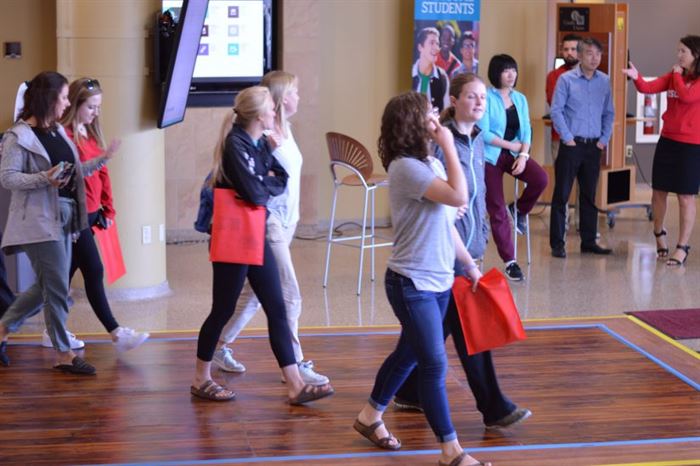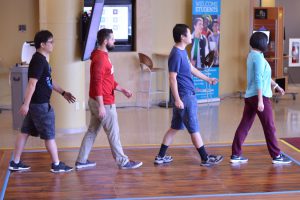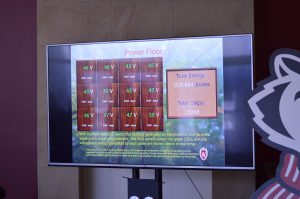9.6.17 | College of Engineering News | Will Cushman | Original Publication

As tens of thousands of visitors each day walk across a new flooring installation in UW-Madison’s Union South in fall 2017, they might not realize they’re participating in what could very well represent a leap into the future of renewable energy production.

A research team led by Xudong Wang, a University of Wisconsin-Madison professor of materials science and engineering, in collaboration with the UW-Madison Grainger Institute for Engineering, has installed a high-tech flooring prototype that harvests the energy of footsteps and converts it into electricity.
The prototype is a 96-square-foot rectangle of modified wood flooring panels located inside the building’s main West Johnson/Orchard Street entrance. It looks just like typical wood flooring, but its low-tech façade masks innovative technology that could soon contribute to the expanding suite of renewable energy options. The power-generating floor includes an additional green credential in that its functional component is mostly made from recycled wood pulp—an abundant waste material.
The wood pulp is central to the technology’s function. The pulp, which is already a common component of flooring, is chemically treated to produce a large number of electrostatic charges when it comes into contact with an embedded electrode due to its significantly different triboelectric polarity. These charges are transmitted through embedded wires and can power lights or charge batteries. And because wood pulp is a cheap, abundant and renewable waste product of several industries, flooring that incorporates the new technology could be as affordable as conventional materials.
While there are existing similar materials for harnessing footstep energy, they’re costly, non-recyclable and impractical at a large scale. That’s why Wang is so excited about the prototype installation in Union South, which is the result of research first published in the journal Nano Energy in 2016.
“This is the first on-site demonstration of our technology,” Wang says. “It shows an exciting path leading materials science technology from the lab toward a real product. It’s also an intriguing technology for energy savings, and is beneficial to our environment.”
Wang’s research centers on the use of mechanical energy sources to generate electricity. For years, he has engineered different materials to improve a technology called a triboelectric nanogenerator (TENG). Triboelectricity is the same phenomenon that produces static electricity on clothing. Chemically treated cellulose nanofibers are a simple, low-cost and effective alternative for harnessing this broadly existing mechanical energy source, Wang says.
The UW-Madison team’s breakthrough is the latest advance in a green energy research field called “roadside energy harvesting” that could, in some settings, rival solar power—and it doesn’t depend on fair weather. Researchers like Wang who study roadside energy harvesting methods see the ground as holding great renewable energy potential well beyond its limited fossil fuel reserves.
“Roadside energy harvesting requires thinking about the places where there is abundant energy we could be harvesting,” Wang says. “We’ve been working a lot on harvesting energy from human activities. One way is to build something to put on people, and another way is to build something that has constant access to people. The ground is the most-used place.”

Someday soon, flooring like the new prototype in Union South could be used in high-traffic spaces to generate power for overhead lighting or smart building sensor networks. The campus prototype powers an electronic informational sign that explains the technology and tracks the power harnessed by thousands of Badger footsteps over the coming months.
“Our initial test in our lab shows that the technology works for millions of cycles without any problem,” Wang says. “We haven’t converted those numbers into years of life for a floor yet, but I think with appropriate design, the technology can outlast the floor itself.”
The Wisconsin Alumni Research Foundation (WARF) holds the patent to the flooring technology and supported this development through its Accelerator Program. The prototype in Union South is the fruition of a collaboration among several UW-Madison parties, including the Grainger Institute for Engineering, the College of Engineering, Forest Products Laboratory, the Wisconsin Union, the office of Risk Management, and office of Environment, Health and Safety.